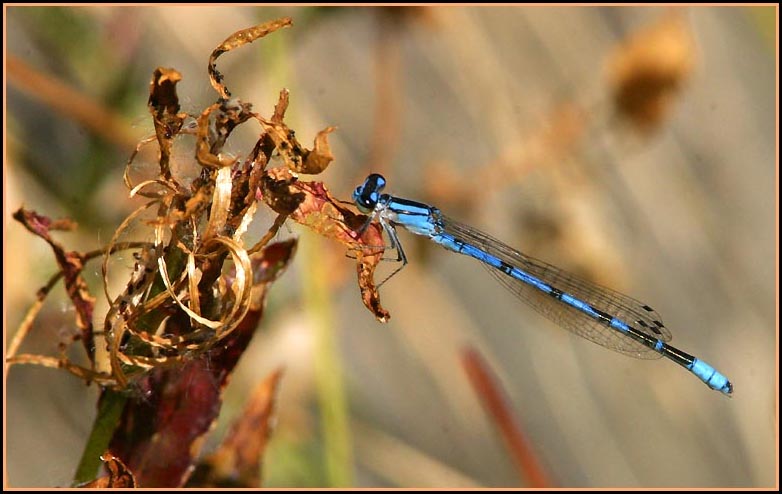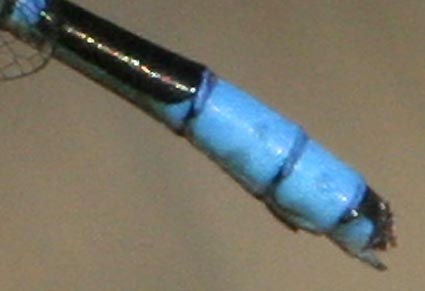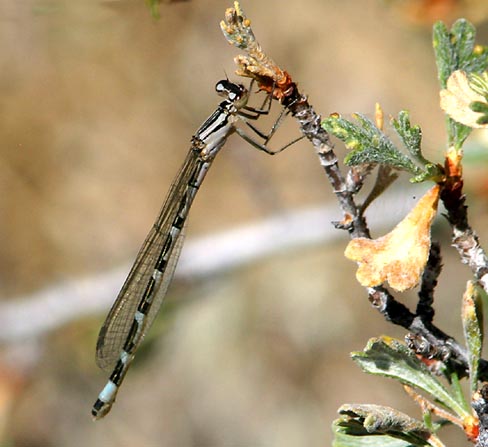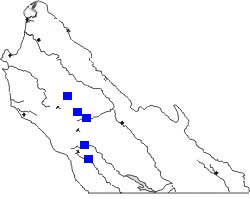| |
|
|
NORTHERN BLUET
Enallagma
annexum
|

photo (above) 9
Sep 2006 Wagon Caves, Los
Padres NF
|
|
|
| Northern Bluet is a common and widespread
bluet across much
of North America. Its range was once thought to include northern
Eurasia,
but recent genetic studies (Turgeon et al. 2005) showed that Eurasian
and
North American populations separated about 250,000 years ago and should
now be considered separate species. The Eurasian Bluet goes by the name
Enallagma
cyathigerum — which was the name given to the combined group (e.g.,
Manolis 2003) — but now that they are split, the North American bluet
is Enallagma annexum. The photo below illustrates
that an abdomen
can be very flexible (all bluets can do contortions).
photo (above) 23
Sep 2006 upper San Antonio
River, Los Padres NF
photo (below) of appendage: 9 Sep
2006 Wagon Caves, Los
Padres NF
|
 Male
Northern Bluets show a lot of blue, and comparatively little black, on
abdominal segments 2 through 5. This helps separate them from Arroyo
and
Tule Bluets. All male bluets are best identified by in-hand views of
the
terminal appendages. The male's lower appendages (paraprocts) are hooks
that are much longer than the upper appendages (cerci; see photo
right).
The cerci themselves have a very tiny hook at the tip — almost too
small
to be seen in this photo but clearly visible with a 10X lens in-hand —
that separates them from the otherwise very similar Boreal Bluet E.
boreale.
Northern and Boreal Bluets often occur together on lakes across much of
North America, including California mountain ranges, and hybridization
is known (McPeek 1990). However, the best interpretation of molecular
data
so far is that these are two reproductively isolated species (Turgeon
et
al. 2005). Male
Northern Bluets show a lot of blue, and comparatively little black, on
abdominal segments 2 through 5. This helps separate them from Arroyo
and
Tule Bluets. All male bluets are best identified by in-hand views of
the
terminal appendages. The male's lower appendages (paraprocts) are hooks
that are much longer than the upper appendages (cerci; see photo
right).
The cerci themselves have a very tiny hook at the tip — almost too
small
to be seen in this photo but clearly visible with a 10X lens in-hand —
that separates them from the otherwise very similar Boreal Bluet E.
boreale.
Northern and Boreal Bluets often occur together on lakes across much of
North America, including California mountain ranges, and hybridization
is known (McPeek 1990). However, the best interpretation of molecular
data
so far is that these are two reproductively isolated species (Turgeon
et
al. 2005).
Boreal Bluet has not yet been recorded in Monterey
County but it is
to be expected. It has been collected in adjacent San Benito County.
Since
it shares similar habitats with Northern Bluet, it might be found at
the
same spots. Boreal Bluet has a shorter flight season than Northern:
just
late April to early September, compared to Northern's mid-March into
October
(Manolis 2003).
|
 Female
Northern Bluets cannot be safely separated from female Boreal Bluets,
even
in-hand (Manolis 2003). Both species show blue atop segment 8, like
shown
on the photo (left). This photo was taken at over 7000' elevation in
Alpine
County, California. I think this photo is of a Northern Bluet because
we
only netted male Northerns at this lake, but it is still just a guess.
I have not yet seen a female bluet of this type (Northern/Boreal) in
MTY. Female
Northern Bluets cannot be safely separated from female Boreal Bluets,
even
in-hand (Manolis 2003). Both species show blue atop segment 8, like
shown
on the photo (left). This photo was taken at over 7000' elevation in
Alpine
County, California. I think this photo is of a Northern Bluet because
we
only netted male Northerns at this lake, but it is still just a guess.
I have not yet seen a female bluet of this type (Northern/Boreal) in
MTY.
Photo (left) 15 Aug 2006 Heenan
Lake, Alpine Co.
|
 Northern
Bluet is very common around high-altitude lakes in montane California
(Manolis
2003). In Monterey County it has been found along streams, rivers, and
seeps in the foothills of the Santa Lucia Mountains (map). It probably
occurs on small montane lakes as well, but such lakes are very few in
MTY.
To
date the elevational range in MTY has been 1600-3200' elevation
(500-975m). Northern
Bluet is very common around high-altitude lakes in montane California
(Manolis
2003). In Monterey County it has been found along streams, rivers, and
seeps in the foothills of the Santa Lucia Mountains (map). It probably
occurs on small montane lakes as well, but such lakes are very few in
MTY.
To
date the elevational range in MTY has been 1600-3200' elevation
(500-975m).
Since it also occurs in Pinnacles National
Monument — in the Diablo
Range of San Benito County just east of MTY — it is probably widespread
in habitat within MTY as well. However, it has not yet been found in
the
Diablo Range in MTY.
MTY flight dates of Northern Bluet range
from 23 Mar–23 Sep. Elsewhere in California
it has been found mid-March to mid-October (Manolis 2003).
|
|
|
Literature cited:
- Manolis, T. 2003. Dragonflies and Damselflies of
California. Univ. of Calif.
Press, Berkeley.
- McPeek, M.A. 1990. Determination of species
composition in the Enallagma
damselfly assemblage of permanent lakes. Ecology 71: 83-98.
- Turgeon, J., R. Stoks, R.A. Thum, J.M. Brown, and
M.A. McPeek. 2005. Simultaneous
Quaternary radiations of three damselfly clades across the Holarctic.
Amer.
Naturalist 165: E78-E107 [electronically published]
Web resources:
Major identification web sites with much information on California
odes include:
For sites with excellent photos to compare for identification or to
simply
enjoy, see:
Many of these sites have links to other useful pages. Kathy Biggs's
site
is particularly useful in her selection of links. |
|
All photos © Don Roberson 2007
TOP
|
|
|
|
|
|
|
|
|
